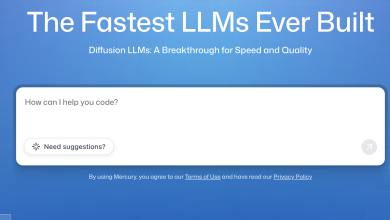
The way people search for information is undergoing a radical change. With the rise of AI-powered search experiences, the rules of visibility, discovery and engagement are being rewritten in real time.
While more information is available than ever before, the way we access it is forever changed. Research has shown that over half of Google users are less likely to click on links when an AI-generated summary appears in the search results. We’re finding things faster, but how that translates to engagement is a little more complicated.
For brands, this is both an opportunity and a wake-up call. Success can no longer be defined by ranking highly on a search results page alone. Increasingly, winning in this space will depend on creating structured, snackable, intent-driven content that surfaces seamlessly across search results, social feeds and AI-powered interfaces.
Search is no longer confined to Google’s ten blue links. And even within Google, the nature of what people see and how they interact with it is rapidly evolving.
Google AI Mode: early days, big questions
Google’s AI Mode has sparked enormous industry interest, but it’s still early days. The long-term question is whether users will adopt this as a fundamental part of their search behaviour. Will AI overviews become the default search experience, or remain an optional layer?
So far, the rollout is experimental. Search results are becoming more visual, more contextual, and more conversational. But as with any behavioural shift, adoption takes time. A critical hurdle is trust. Will people be comfortable letting agentic AI systems not only suggest but act – booking holidays, purchasing products, or managing schedules? Transparency will be key to building this confidence. If AI can provide reassurance around accuracy, fairness and privacy, adoption will accelerate rapidly.
For brands, the lesson is clear: prepare now. Waiting for consumer adoption to “settle” risks being left behind.
Meeting users where they are
The reality is that search behaviour is already highly fragmented. Whatever your age or demographic, you’ll use a mix of search experiences across different platforms. Younger audiences are increasingly searching via TikTok. Others lean on niche players or voice assistants. Google remains the most important search engine globally, but it’s no longer the only search engine that matters.
The challenge for brands is to meet users where they are. That requires a holistic approach to visibility. You need to understand where your audiences are searching, what formats resonate most in those environments, and how to futureproof your presence across multiple platforms.
Take Gymshark as an example. A Gen Z fitness enthusiast looking for workout motivation might never visit Gymshark’s website directly. Instead, they’ll discover the brand through TikTok fitness influencers showcasing #Gymshark content, or Instagram Reels featuring transformation stories and workout routines.
Meanwhile, a millennial professional researching high-quality activewear might start with Amazon reviews comparing Gymshark leggings to Lululemon, while fitness-focused audiences increasingly rely on AI-driven summaries from ChatGPT or Perplexity when asking “best gym clothes for powerlifting.”
Without understanding where these different demographics are searching, Gymshark would risk concentrating all its SEO efforts on traditional Google rankings while competitors like Alphalete or YoungLA quietly build authority through creator partnerships and social search optimisation in the spaces where their target audience is actually discovering new brands.
This is where audience analysis becomes essential. Identifying where your customers “play” – whether in traditional search, social search or AI-driven interfaces – ensures you don’t lose ground to local competitors or nimble challengers who are already gaining traction in these spaces.
The new search reality
AI search is accelerating the shift toward “zero-click” journeys, where users get answers instantly, without ever visiting a brand’s site. For marketers, this breaks the old model of measurement. Traffic alone won’t cut it. What matters now is visibility: share of voice in AI summaries, brand mentions and citations, and engagement with structured content across platforms.
That shift also demands a new mindset. SEO isn’t dead, but it’s no longer enough. Brands need to think in terms of search experience optimisation – creating content that AI can parse, signals it can trust, and assets that resonate wherever users are searching, from traditional engines to social to voice. Search today is more visual, conversational and intent-driven, and strategies need to evolve with it.
Looming over all of this is governance, or rather, the lack of it. With no clear rules on how AI search systems operate or how brands are represented, unpredictability is the norm. That creates risk, but also responsibility. Brands that proactively safeguard their reputation, while adapting to these new behaviours, will be the ones that shape the road ahead.
Embracing the new frontier
AI-powered search isn’t just a technological update. It’s a fundamental shift in how people discover and engage with information. Brands that cling to the old model of search will quickly lose ground, while those that adapt will not only remain relevant but thrive.
That adaptation starts with visibility. Brands need to understand where they already appear across AI overviews, social search results and traditional listings.
From there, the focus should be on creating structured, intent-driven content—content that offers clarity, context and authority, and therefore has the best chance of being surfaced in AI-generated summaries. At the same time, audience analysis has never been more important: mapping demographic behaviours ensures brands are showing up in the places their customers are actually searching. As we explore in our whitepaper on the future of search, this shift isn’t about replacing existing strategies, but rather rethinking how visibility is built within a multi-layered search ecosystem.
Above all, agility is key. This landscape is moving quickly, and the brands that stay curious – testing, learning and iterating – will be the ones to stay ahead. The lesson is simple: don’t wait for AI search to “arrive.” It’s already here, and the brands that prepare today will own the conversation tomorrow.





